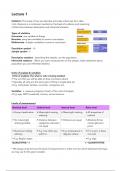Digital methods –
Communicatiewetenschappen
INTRODUCTION
Importance of this course
From a job perspective:
➔ Gain hands-on experience with (some) tools and be able to learn new tools that are
relevant for the job market at any given moment in time.
From a societal perspective:
➔ Demystify digital data stories and develop a critical attitude.
o E.g. Cambridge Analytica
o Vlaams Belang has won the elections because of social
media. Digital methods and the social sciences
➔ Set of methods to ask questions regarding:
o digital technologies and their implications on the social,
o the offline (social) world using the digital.
➔ Methods:
o Quantitative (surveys, experiments, trace data, big data, content analysis, …)
o Qualitative (ethnography, participant observations, interviews, textual analysis)
➔ Digital methods:
o Inclusive
o Data analysis embedded in ‘traditional’ statistical approaches
➔ Concerns:
o Validity:
▪ Are we measuring what we intend to measure?
▪ What is the range of our insights?
o Reliability:
▪ If we were to repeat this study, would we find the same results?
o Data quality & meaning:
▪ How are online and offline related?
▪ Can they be considered as separate from each other?
Ethnography
= Study of cultural phenomena through methods such as observation, participation, interviews,
analysis of log data.
The digital street (Lane, 2015)
Study of street life of teenagers in Harlem.
➔ Social life on the street unfolds in person and through social media.
➔ In order to understand street culture it is important to take into account the online aspect
in addition to the offline. (hence social reality = online + offline)
Methods?
, ➔ As media become more pervasive in everyday life, classical fieldwork (observations,
interviews,…) are not sufficient to anymore to understand human interactions and
culture(s).
➔ Combination of urban and digital ethnography to study social life of the street.
o The digital is approached by:
▪ getting access to phone records,
▪ gaining access to social media data (Instagram, Twitter, Facebook)
including private messages.
➔ Analysis is embedded in ethnographic tradition: close-up, long-term participant
observation in the field.
Experiments
Online experiments
= conducting experimental research through the use of the interent
Amazon’s Mechanical Turk
Amazon Mechanical Turk (MTurk) is a crowdsourcing marketplace that makes it easier for
individuals and businesses to outsource their processes and jobs to a distributed workforce who can
perform these tasks virtually
➔ Conducting simple data validation and research
➔ Survey participation
➔ Content moderation
➔ …
MTurk enables companies to harness the collective intelligence, skills, and insights from a global
workforce to streamline business processes, augment data collection and analysis, and accelerate
machine learning development.
Quasi-experiments
= An experimental design that differs from a classic experimental design, either because
randomisation is not possible or because no real comparison group has been established
Neighbourhoods in the network society: the e-neighbours study ~Keith N.
Hampton
➔ To what extent does the internet help in forming local social ties?
➔ Quasi-experimental design with 4 “neighbourhoods
o Neighbourhood 1, 2 & 3: e-mail discussion list + website
o Neighbourhood 4: control group
➔ No randomisation
,Website functionalities
- A user profile that included demographics, information on personal interests and space
for personal comments
- A searchable neighbourhood directory that included information from neighbours’ profiles
- A match maker that matched participants based on common interests, hobbies , histories,…
- An instant messenger that identified which neighbours were connected to the internet
and available to chat
- A community calendar
- A forum to provide and comment on recommendations for local business and services
- A forum to list classified ads and items for sale
- A community poll that allowed participants to create multiple choice survey questions
that were presented to other users for the neighbourhood website
Methods & analysis
➔ 3 annual surveys (2002/2003/2004) in 4 Boston neighbourhoods
o Socio-demographic, technology use, network position-and name generators,…
o Estimated response rate: 26 percent
➔ Analysis:
o Hierarchical linear model (2 levels)
o Content analysis of e-mail lists
o Cross-tabs
Relevance of digital methods for this research
➔ Analysis was embedded in traditional regression approach
o Content analysis of digital messages from the e-mail lists
o Whether e-mail list was used at least once
o Number of visits to website
, Lab experiments
= A laboratory experiment is an experiment conducted under highly controlled conditions (not
necessarily a laboratory), where accurate measurements are possible
Effects of prosocial video games on prosocial behaviour ~Greitemeyer & Osswald
➔ Is playing prosocial video-games more likely to elicit prosocial behaviour compared to
neutral and violent video games?
➔ Experiment 1: help with picking up pencils that experimenter dropped
➔ Experiment 2: willingness to assist in another study for student’s master thesis
➔ Experiment 3: helping a harassed woman
➔ Experiment 4: write down thoughts + pencil dropping
Relevance of digital methods for this research
➔ Games as digital technologies used to study the relationship between technology and
the social (prosocial behaviors in this case)
➔ Analysis is embedded in traditional experimental analyses (ANOVA, t-test, chi2)
NewsDNA
➔ A multidisciplinary four year research project (2018-2022)
➔ Aim: develop and test an algorithm that used new diversity as a key driver for
personalised news recommendation
Trace data
= Data generated by digital media and technologies in interaction with users
➔ Consist of a large range of artifacts such as
o Social media data
o Instant messaging exchanges
o Mobile call data
o Mobile phone usage patterns
o Gaming behaviour
o E-mail exchanges
o Discussion fora
Communicatiewetenschappen
INTRODUCTION
Importance of this course
From a job perspective:
➔ Gain hands-on experience with (some) tools and be able to learn new tools that are
relevant for the job market at any given moment in time.
From a societal perspective:
➔ Demystify digital data stories and develop a critical attitude.
o E.g. Cambridge Analytica
o Vlaams Belang has won the elections because of social
media. Digital methods and the social sciences
➔ Set of methods to ask questions regarding:
o digital technologies and their implications on the social,
o the offline (social) world using the digital.
➔ Methods:
o Quantitative (surveys, experiments, trace data, big data, content analysis, …)
o Qualitative (ethnography, participant observations, interviews, textual analysis)
➔ Digital methods:
o Inclusive
o Data analysis embedded in ‘traditional’ statistical approaches
➔ Concerns:
o Validity:
▪ Are we measuring what we intend to measure?
▪ What is the range of our insights?
o Reliability:
▪ If we were to repeat this study, would we find the same results?
o Data quality & meaning:
▪ How are online and offline related?
▪ Can they be considered as separate from each other?
Ethnography
= Study of cultural phenomena through methods such as observation, participation, interviews,
analysis of log data.
The digital street (Lane, 2015)
Study of street life of teenagers in Harlem.
➔ Social life on the street unfolds in person and through social media.
➔ In order to understand street culture it is important to take into account the online aspect
in addition to the offline. (hence social reality = online + offline)
Methods?
, ➔ As media become more pervasive in everyday life, classical fieldwork (observations,
interviews,…) are not sufficient to anymore to understand human interactions and
culture(s).
➔ Combination of urban and digital ethnography to study social life of the street.
o The digital is approached by:
▪ getting access to phone records,
▪ gaining access to social media data (Instagram, Twitter, Facebook)
including private messages.
➔ Analysis is embedded in ethnographic tradition: close-up, long-term participant
observation in the field.
Experiments
Online experiments
= conducting experimental research through the use of the interent
Amazon’s Mechanical Turk
Amazon Mechanical Turk (MTurk) is a crowdsourcing marketplace that makes it easier for
individuals and businesses to outsource their processes and jobs to a distributed workforce who can
perform these tasks virtually
➔ Conducting simple data validation and research
➔ Survey participation
➔ Content moderation
➔ …
MTurk enables companies to harness the collective intelligence, skills, and insights from a global
workforce to streamline business processes, augment data collection and analysis, and accelerate
machine learning development.
Quasi-experiments
= An experimental design that differs from a classic experimental design, either because
randomisation is not possible or because no real comparison group has been established
Neighbourhoods in the network society: the e-neighbours study ~Keith N.
Hampton
➔ To what extent does the internet help in forming local social ties?
➔ Quasi-experimental design with 4 “neighbourhoods
o Neighbourhood 1, 2 & 3: e-mail discussion list + website
o Neighbourhood 4: control group
➔ No randomisation
,Website functionalities
- A user profile that included demographics, information on personal interests and space
for personal comments
- A searchable neighbourhood directory that included information from neighbours’ profiles
- A match maker that matched participants based on common interests, hobbies , histories,…
- An instant messenger that identified which neighbours were connected to the internet
and available to chat
- A community calendar
- A forum to provide and comment on recommendations for local business and services
- A forum to list classified ads and items for sale
- A community poll that allowed participants to create multiple choice survey questions
that were presented to other users for the neighbourhood website
Methods & analysis
➔ 3 annual surveys (2002/2003/2004) in 4 Boston neighbourhoods
o Socio-demographic, technology use, network position-and name generators,…
o Estimated response rate: 26 percent
➔ Analysis:
o Hierarchical linear model (2 levels)
o Content analysis of e-mail lists
o Cross-tabs
Relevance of digital methods for this research
➔ Analysis was embedded in traditional regression approach
o Content analysis of digital messages from the e-mail lists
o Whether e-mail list was used at least once
o Number of visits to website
, Lab experiments
= A laboratory experiment is an experiment conducted under highly controlled conditions (not
necessarily a laboratory), where accurate measurements are possible
Effects of prosocial video games on prosocial behaviour ~Greitemeyer & Osswald
➔ Is playing prosocial video-games more likely to elicit prosocial behaviour compared to
neutral and violent video games?
➔ Experiment 1: help with picking up pencils that experimenter dropped
➔ Experiment 2: willingness to assist in another study for student’s master thesis
➔ Experiment 3: helping a harassed woman
➔ Experiment 4: write down thoughts + pencil dropping
Relevance of digital methods for this research
➔ Games as digital technologies used to study the relationship between technology and
the social (prosocial behaviors in this case)
➔ Analysis is embedded in traditional experimental analyses (ANOVA, t-test, chi2)
NewsDNA
➔ A multidisciplinary four year research project (2018-2022)
➔ Aim: develop and test an algorithm that used new diversity as a key driver for
personalised news recommendation
Trace data
= Data generated by digital media and technologies in interaction with users
➔ Consist of a large range of artifacts such as
o Social media data
o Instant messaging exchanges
o Mobile call data
o Mobile phone usage patterns
o Gaming behaviour
o E-mail exchanges
o Discussion fora










